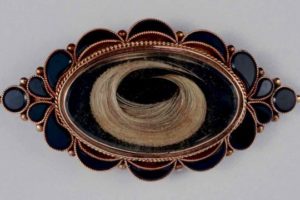October is one of the most beautiful months with both the majestic opal as well as the multi-colored tourmaline as birthstone choices. The opal is known as the “Queen” of all gemstones. Pliny the Elder (23AD-79AD) described the opal: “There is in them a softer fire than the ruby, there is the brilliant purple of the amethyst and the sea green of the emerald, all shining together in incredible union.”
The fire that is mentioned in this quote is created by the opal’s unique formation in the fissures of volcanic rock. Here, its composition uniquely includes hydrated silica spheres. These spheres bend the white light the opal receives thus causing the rainbow like effect for which they are famous. Opals are soft (5.5-6.5 on the Mohs Scale) and they do react to temperature changes due to their hydrated nature. Care must be taken both with wear and storage. There are several types of opals, which include: white, boulder, jelly, colored opaque, fire, and the most valuable, black. Opals are famous for being mined in Australia, but recently a more durable, colorful specimen has been found in Ethiopia. Currently the Ethiopian opal offers more “bang for your buck” but as other opals become scarcer, the Ethiopians will no doubt increase in price. Buying now would be a good idea for the savvy opal collector.
Opals have the misfortune of being considered unlucky. These legends are often associated with Sir Walter Scott’s work, Anne of Geirstein, where the heroine received an opal which was believed to lead to her untimely death. Even though this story was authored in 1829, and few contemporary readers are familiar with the plot, many people still have heard that opals are dangerous, or only for those brave October babies.
Opals are the traditional birthstone for October, but they are also astrally linked to the Zodiac signs of Pisces and Cancer. The opals are most powerful when touching the skin. The healing properties are aligned with the stomach and digestion, as well as regulating metabolism as it relates to the glands. Many people also use the opal for meditation. It is supposed to help restore inner harmony especially when a heart has been broken. (I know I feel better when I receive jewelry!)
 The second choice for October babies is the Tourmaline. This stone comes in almost any color depending on the trace elements within the stone. The primary color associated with this month is pink, but modern wearers may use all of the colors.
Tourmaline is a more durable stone than the opal, with a 7 to 7.5 on the Mohs Scale. Tourmalines also have an interesting quality in the fact that if you rub them, they become electrostatically charged. Other astral signs associated with the tourmaline include: Libra (Blue/Indicolite), Capricorn (Green/Verdilite), and Scorpio (Pink/Red/ Rubellite).
As the reader may imagine, the trace elements that change the color of tourmaline also change what the gemstone may do therapeutically. The pink/red tourmalines are associated with friendship, love, and the female sex organs. (Yeah!) The health applications include regulating female metabolism as well as blood circulation for the sex organs. (Yeah, Yeah…that rhymes with Vajay-jay! Coincidence? You decide!) Santa Baby, I’d like some pink tourmaline too, not blue. I’ve been an awfully good girl…I digress.
Another variation which is specifically associated with the month of October is the watermelon tourmaline. This is pink in the center with green around the edge, like its namesake. It is used for strengthening the immune system, alleviating pain, and protecting the nerve cells.
The second choice for October babies is the Tourmaline. This stone comes in almost any color depending on the trace elements within the stone. The primary color associated with this month is pink, but modern wearers may use all of the colors.
Tourmaline is a more durable stone than the opal, with a 7 to 7.5 on the Mohs Scale. Tourmalines also have an interesting quality in the fact that if you rub them, they become electrostatically charged. Other astral signs associated with the tourmaline include: Libra (Blue/Indicolite), Capricorn (Green/Verdilite), and Scorpio (Pink/Red/ Rubellite).
As the reader may imagine, the trace elements that change the color of tourmaline also change what the gemstone may do therapeutically. The pink/red tourmalines are associated with friendship, love, and the female sex organs. (Yeah!) The health applications include regulating female metabolism as well as blood circulation for the sex organs. (Yeah, Yeah…that rhymes with Vajay-jay! Coincidence? You decide!) Santa Baby, I’d like some pink tourmaline too, not blue. I’ve been an awfully good girl…I digress.
Another variation which is specifically associated with the month of October is the watermelon tourmaline. This is pink in the center with green around the edge, like its namesake. It is used for strengthening the immune system, alleviating pain, and protecting the nerve cells.
 Ah, but November, I didn’t forget you. Not unlike the tourmaline, your traditional choice is the topaz. This stone also comes in a myriad of colors, but primarily it is linked to the Imperial Topaz which is a naturally occurring stone (no heat treatment), in a beautiful peach nectar color. It is a durable stone, rating an 8 on the Mohs Scale. It can withstand daily wear with little concern. The Topaz is an ancient revered stone which was mentioned in the Bible for its protective symbolism.
Topaz is the stone of joy and self-realization. It is said to help calm the wearer, help with metabolism and indigestion, aid in sleeping disorders, and help refine the taste-buds. If that was not enough, the Golden Topaz is also associated with the astral sign of Virgo. Pink topaz is linked to Leo, and the many shades of blue topaz are linked to Aquarius.
Ah, but November, I didn’t forget you. Not unlike the tourmaline, your traditional choice is the topaz. This stone also comes in a myriad of colors, but primarily it is linked to the Imperial Topaz which is a naturally occurring stone (no heat treatment), in a beautiful peach nectar color. It is a durable stone, rating an 8 on the Mohs Scale. It can withstand daily wear with little concern. The Topaz is an ancient revered stone which was mentioned in the Bible for its protective symbolism.
Topaz is the stone of joy and self-realization. It is said to help calm the wearer, help with metabolism and indigestion, aid in sleeping disorders, and help refine the taste-buds. If that was not enough, the Golden Topaz is also associated with the astral sign of Virgo. Pink topaz is linked to Leo, and the many shades of blue topaz are linked to Aquarius.
 The next stone for November is the modern choice of the citrine. It is the yellow member of the quartz family. Citrines have a long history of being used for healing. Caesar’s legions wore citrines on their chests under their armor because the stones were believed to be a life-saving talisman.
The citrine is also astrally linked to Gemini’s (Me) and Virgos. I love citrine, personally, because it is durable and stands up to daily wear. I also love any color of yellow. The color range of citrine can be dark, almost brown in color, to the more expensive orange color called the Madeira, finally to the lighter buttery yellow which is usually less expensive per carat. Citrine is also another stone that wears better next to the skin. It should never be worn in combination with clear quartz as it can actually radiate heat.
Citrine is known to help with organs associated with the solar plexus, such as the lungs, the stomach, and the liver. It is also said to help with anxiety and panic disorders. I often combine citrine with turquoise as a power packed duo for my personal needs. (Turquoise is often associated with bodily protection and protection while traveling.) I always wear these stones when I fly to any destination.
As I have read through this article, I noticed that I have mentioned the Mohs Scale frequently. For those of you who are not rock nerds, or don’t remember high school’s general science class, this terminology might be confusing. The Mohs Scale was designed by German mineralogist, Friedrich Mohs. It is used to explain the hardness (scratch-resistance) of several common minerals with a rating of 1 to 10. This hardness rating is a direct result of the atomic structure and chemical composition of a particular gemstone. It is said that anything with less than a 6 rating is not durable enough to resist scratching and chipping with general use. This practical knowledge is important to think about when wearing a stone in a ring versus a pendant or in a prong mounting versus a bezeled mounting. Here is just the basic scale: 1) talc, 2) gypsum, 3) calcite, 4) fluorite, 5) apatite, 6) feldspar (Moonstone/Labradorite), 7) quartz, 8) topaz, 9) corundum (sapphire and ruby), and 10) diamond.
Friends, we have come to the close of another article. It is my hope that you have learned a little something and maybe laughed some. Always, if you have questions or concerns, please contact me via my e-mail violets4gigi@gmail.com. Next month we will explore the birthstones for the month of December and start on the noble metals. Shalom.]]>
The next stone for November is the modern choice of the citrine. It is the yellow member of the quartz family. Citrines have a long history of being used for healing. Caesar’s legions wore citrines on their chests under their armor because the stones were believed to be a life-saving talisman.
The citrine is also astrally linked to Gemini’s (Me) and Virgos. I love citrine, personally, because it is durable and stands up to daily wear. I also love any color of yellow. The color range of citrine can be dark, almost brown in color, to the more expensive orange color called the Madeira, finally to the lighter buttery yellow which is usually less expensive per carat. Citrine is also another stone that wears better next to the skin. It should never be worn in combination with clear quartz as it can actually radiate heat.
Citrine is known to help with organs associated with the solar plexus, such as the lungs, the stomach, and the liver. It is also said to help with anxiety and panic disorders. I often combine citrine with turquoise as a power packed duo for my personal needs. (Turquoise is often associated with bodily protection and protection while traveling.) I always wear these stones when I fly to any destination.
As I have read through this article, I noticed that I have mentioned the Mohs Scale frequently. For those of you who are not rock nerds, or don’t remember high school’s general science class, this terminology might be confusing. The Mohs Scale was designed by German mineralogist, Friedrich Mohs. It is used to explain the hardness (scratch-resistance) of several common minerals with a rating of 1 to 10. This hardness rating is a direct result of the atomic structure and chemical composition of a particular gemstone. It is said that anything with less than a 6 rating is not durable enough to resist scratching and chipping with general use. This practical knowledge is important to think about when wearing a stone in a ring versus a pendant or in a prong mounting versus a bezeled mounting. Here is just the basic scale: 1) talc, 2) gypsum, 3) calcite, 4) fluorite, 5) apatite, 6) feldspar (Moonstone/Labradorite), 7) quartz, 8) topaz, 9) corundum (sapphire and ruby), and 10) diamond.
Friends, we have come to the close of another article. It is my hope that you have learned a little something and maybe laughed some. Always, if you have questions or concerns, please contact me via my e-mail violets4gigi@gmail.com. Next month we will explore the birthstones for the month of December and start on the noble metals. Shalom.]]>
You also might be interested in
Necklaces and lockets were often fashioned of braided hair [...]
While we awaken, food becomes less and less necessary [...]
About Bellesprit

Bellésprit (pronounced bell-e-spree) was born out of a desire to educate those who seek to expand their knowledge along their spiritual path. Featuring many contributors who are experts in their field, Bellésprit has a little bit of something for everyone who desires to learn more about spirituality, metaphysics, and the paranormal world.



